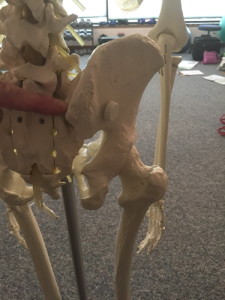Our bodies are amazingly capable of compensating, allowing us to continue to move and function in our busy lives. Unfortunately, compensation often comes with a cost. The Sacroiliac joint (SI joint) is a common source of compensation and pain when movement elsewhere in the body becomes problematic. The most common issue I see in the clinic underneath SI joint pain, is hip joint dysfunction. If you look at the picture below – I am pointing to the SI joint. Notice the hip joint just around the corner and the lower spine just above. The SI joint sits right between the two. When the elegantly designed mobile, ball and socket joint of the hip isn’t in a position to do it’s job, shifting weight from right leg to left leg as with walking and running, the SI joint and spine often try to “help out” with this movement and pain is the result.

I suggest that patients with SI pain have probably stopped using their body as directed by their “owners manual” (instructions that came with you at birth for proper use of your body – but you may have lost track of by now?). When we are born in healthy circumstances our bodies intuitively use our joints and structure in a balanced, efficient and natural way. If we look at most young children moving and playing, it becomes apparent they have no difficulty with running, jumping and squatting in a way that seems balanced, effortless and frankly fun! As we age, we may begin to hold ourselves differently related to stress , prolonged sitting and computer work or with faulty ideas about “good posture” making us believe we should look like a drill sargeant with our chest up and the low back overextended. People with chronic SI joint pain often get temporary relief with manipulations and adjustments, however, if big picture movement patterns don’t change, recurrence of SI joint compensation and pain is most likely.
To resolve chronic SI joint pain, we start with correcting the resting position of the pelvis and rib cage so the hips are in a “neutral” starting position (the way our owners manual says to be when we are at rest). This often involves improving breathing patterns, core muscle position and strength. Once we have a good starting position, then we teach patients to use their hips more effectively during movement, particularly those muscles that help stabilize the SI joint – like the glut max.
Remember, it’s not “normal” to have SI pain with activities like walking or running. Be curious about why that may be, and what you can do to have more fun with movement instead of pain.



